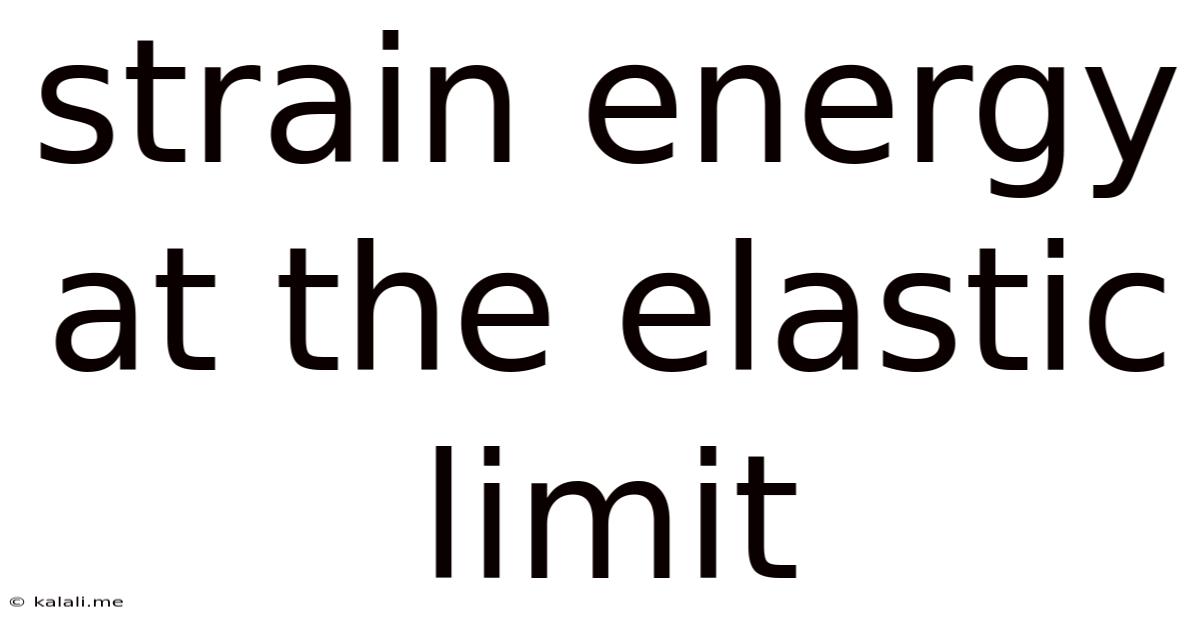Strain Energy At The Elastic Limit
Kalali
Jun 11, 2025 · 3 min read

Table of Contents
Strain Energy at the Elastic Limit: Understanding Material Behavior
Meta Description: Discover the concept of strain energy, its relationship to the elastic limit of a material, and how it impacts engineering design. Learn about elastic deformation, yielding, and the importance of understanding stress-strain curves.
Strain energy is a crucial concept in materials science and engineering. It represents the energy stored within a material when it's deformed elastically. Understanding strain energy, particularly at the elastic limit, is vital for predicting material failure and designing safe and reliable structures. This article will explore the relationship between strain energy and the elastic limit, shedding light on this important aspect of material behavior.
What is Strain Energy?
Strain energy is the energy absorbed by a material as it deforms elastically under an applied load. Think of it as the potential energy stored within the material due to the internal stresses created by this deformation. This energy is recoverable; when the load is removed, the material returns to its original shape, releasing the stored energy. The amount of strain energy stored depends on the material's properties, the applied load, and the extent of the deformation.
Elastic Limit and Yield Strength
Before diving deeper into strain energy at the elastic limit, let's define key terms:
- Elastic Limit: This is the point up to which a material can deform elastically and fully recover its original shape upon removal of the load. Beyond this limit, permanent deformation (plastic deformation) occurs.
- Yield Strength: This is the stress at which a material begins to deform plastically. While closely related to the elastic limit, the yield strength is often more precisely measurable. It marks the transition from elastic to plastic behavior.
Calculating Strain Energy
The strain energy (U) stored in a material undergoing elastic deformation can be calculated using several methods, depending on the type of loading and the material's stress-strain relationship. A common approach involves integrating the area under the stress-strain curve up to a specific point. For a linearly elastic material (obeying Hooke's Law), the formula is:
U = (1/2) * σ * ε * V
Where:
σis the stressεis the strainVis the volume of the material
This formula represents the area of a triangle under the linear portion of the stress-strain curve. For non-linear elastic materials, numerical integration techniques are necessary.
Strain Energy at the Elastic Limit: Significance
The strain energy at the elastic limit represents the maximum amount of energy a material can store elastically before permanent deformation begins. This is a critical value for engineers, as exceeding this limit can lead to:
- Permanent deformation: The material will not return to its original shape after the load is removed.
- Reduced stiffness: The material will become less resistant to further deformation.
- Potential failure: In extreme cases, exceeding the elastic limit can cause fracture or catastrophic failure.
Importance in Engineering Design
Understanding strain energy at the elastic limit is paramount in various engineering applications. Engineers use this knowledge to:
- Select appropriate materials: Choosing materials with high strain energy density ensures components can withstand greater loads before permanent deformation.
- Design safe structures: Structures are designed to operate well below the elastic limit of their constituent materials, ensuring durability and safety.
- Predict material failure: Knowing the strain energy at the elastic limit allows for more accurate prediction of material behavior under various loading conditions.
- Optimize component design: Engineers can optimize designs to minimize weight while maintaining sufficient strength by considering the strain energy capacity of materials.
Conclusion
Strain energy at the elastic limit is a fundamental concept in understanding material behavior. The ability to calculate and interpret strain energy provides crucial insights into material strength, durability, and failure mechanisms, guiding engineers in designing safe and reliable structures and components. Further exploration into advanced material properties and failure theories will enhance the understanding of this critical aspect of engineering design.
Latest Posts
Latest Posts
-
How Many Positions Are There In Sex
Jul 02, 2025
-
How Many Minutes Are In 10 Miles
Jul 02, 2025
-
How Many Milliseconds Are In A Day
Jul 02, 2025
-
If Your 16 What Year Were You Born
Jul 02, 2025
-
Ten Thousand 2 Hundrad And 14 How To Writew Numercally
Jul 02, 2025
Related Post
Thank you for visiting our website which covers about Strain Energy At The Elastic Limit . We hope the information provided has been useful to you. Feel free to contact us if you have any questions or need further assistance. See you next time and don't miss to bookmark.